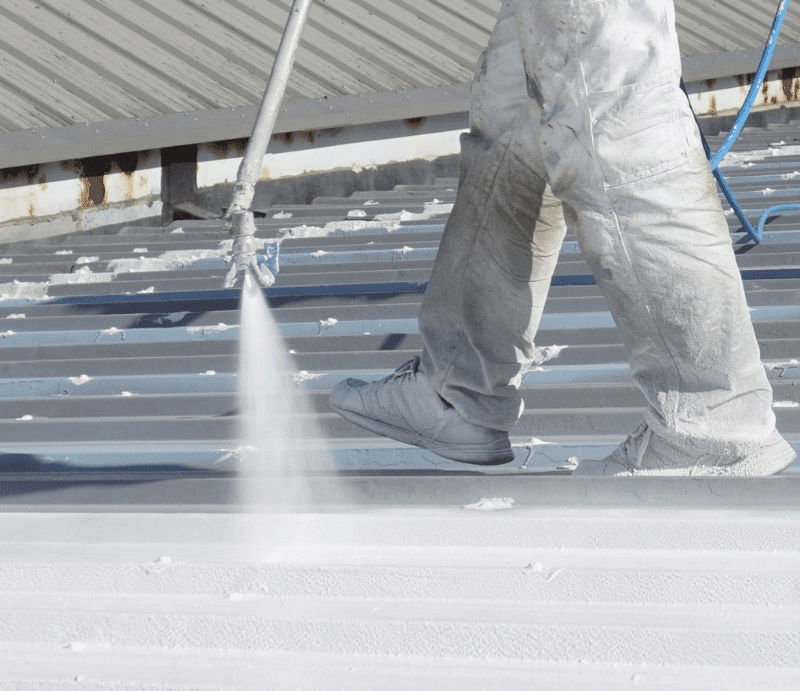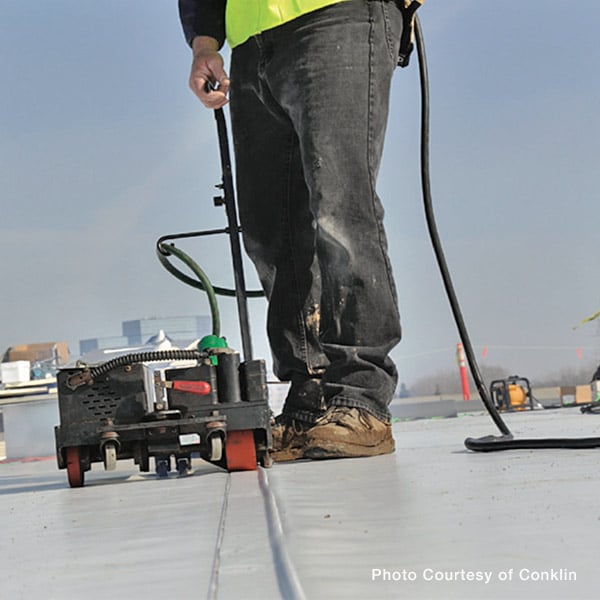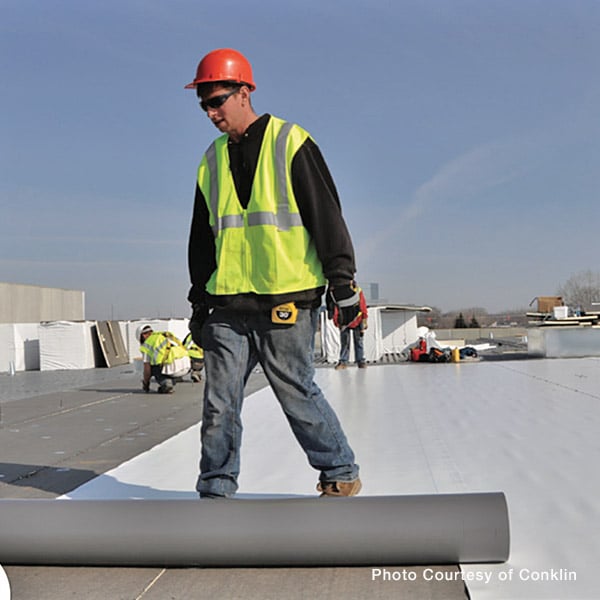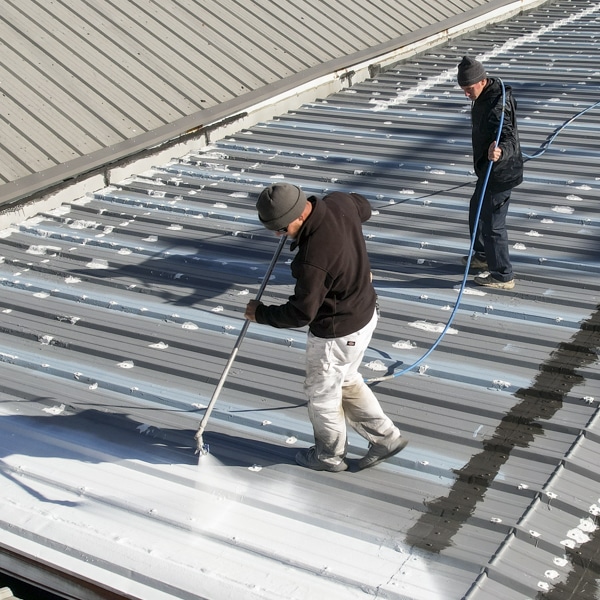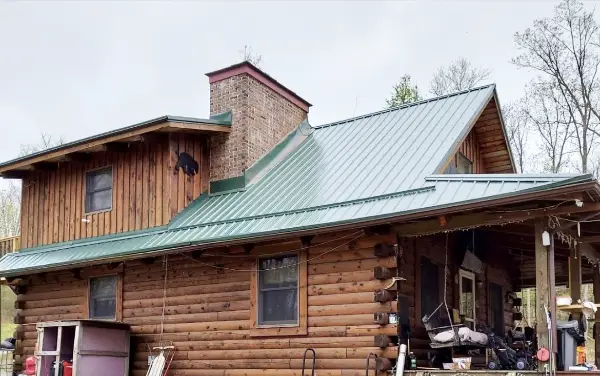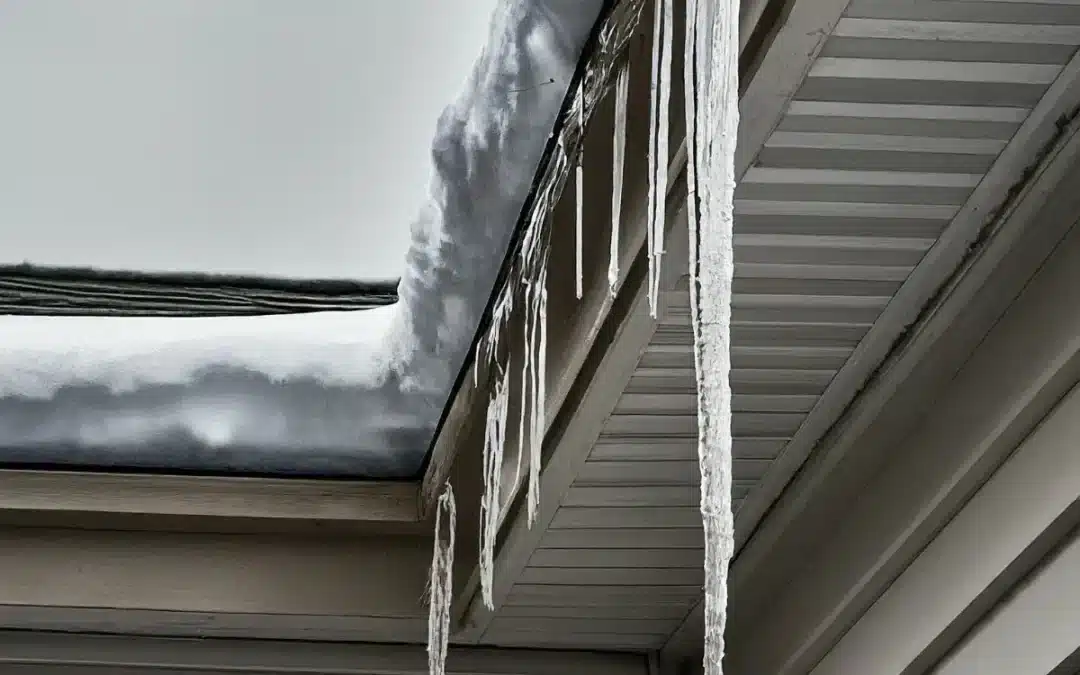Maintaining the integrity of your building’s roof is crucial for any business. Not only does it protect the building and its contents (including your staff!) from the elements, but it also plays a significant role in the overall efficiency and appearance of the structure. A well-maintained roof can last for many decades, while neglect can lead to frequent, costly repairs or even premature replacement. As experts in commercial metal roof repair, not a day goes by when we don’t see a flagging roof that couldn’t have been saved through a little TLC and timely repair.
We’re on a mission to ensure all roofs in Pennsylvania live long healthy lives. To that end, we’ve put together this guide to commercial metal roof repair. In it you’ll discover the most common problems that occur in metal roofs, how you can prevent them, how they can be repaired if they do occur, and how to know when you’re better off replacing rather than repairing a metal roof. By understanding and implementing the practices and tips we’re sharing here, you can ensure your building’s roof remains durable, efficient, and aesthetically pleasing for years to come, which will save you money and a whole lot of hassle in the long run.
Common problems with metal roofs on commercial buildings
Metal roofs are known for their durability and longevity, but like any roofing material, they can develop issues over time. Understanding these common problems can help you identify and address them early, ensuring your workers remain safe and reducing the chance of more costly repairs or replacement being needed.
Corrosion and rust
One of the primary concerns with metal roofs is corrosion, particularly if the roof is not properly coated or maintained. Exposure to moisture, salt, and other environmental factors can cause the metal to rust, leading to weakened structural integrity and potential leaks. Regular inspections and maintenance can help prevent rust from becoming a significant issue.
Lester’s tip
Most people think corrosion from salt is only an issue on the cost. But road salt used to keep our roads drivable in winter can also contribute to metal roof corrosion, so we do see quite a bit of this here in Pennsylvania.
Leaks and water damage
Despite their durability, metal roofs can develop leaks, especially around seams, fasteners, and penetrations such as vents and skylights. Poor installation increases the chances of such problems occurring, and age can exacerbate them, allowing water to seep through and cause damage to the underlying structure. Identifying leaks early and ensuring proper sealing can mitigate extensive water damage.
Thermal movement
Metal roofs expand and contract with temperature changes. Over time, this thermal movement can cause fasteners to loosen and seams to separate, creating gaps that allow water infiltration. Ensuring the roof is installed with the correct fasteners and allowing for thermal movement can help prevent these issues.
Lester’s tip
Thermal movement is a particular issue here in Pennsylvania, as we have such temperature extremes with our hot summers and icy winters.
Scratches and punctures
Foot traffic (during installation and regular maintenance), falling debris, and installation errors can lead to scratches and punctures in the metal roofing material. This damage affects the aesthetic appeal and compromises the roof’s protective barrier, making it susceptible to corrosion and leaks. Using resilient materials and prevention techniques during installation and maintenance can minimize these risks.
Fading and chalk
Over time, the paint or coating on a metal roof can fade or chalk, especially with prolonged exposure to UV rays. While this does not typically impact on the roof’s performance, it can impact the building’s overall appearance and consequently, can put off potential customers and clients. Choosing high-quality coatings and performing regular maintenance can keep your roof looking its best.
How to repair a metal roof
Repairing a metal roof may seem daunting, but with the right approach and tools, it can be a manageable task. Whether you decide to tackle the repairs yourself or hire a professional, understanding the process is essential, so here’s a step-by-step guide on how to repair a metal roof.
1. Identify the problem areas
The first step in repairing a metal roof is to conduct a thorough inspection. Look for signs of rust, leaks, loose fasteners, and damaged panels. Pay special attention to seams, fasteners, and roof penetrations, as these are common problem areas. Mark any damaged spots for repair.
If you’d like some help with this, we’re currently offering free commercial roof inspections — obligation free.
2. Gather the necessary tools and materials
Before starting the repair, ensure you have all the necessary tools and materials. Common items include:
- Metal roof sealant
- Replacement panels
- Fasteners and washers
- Metal cutting tools
- Wire brush
- Rust inhibitor
- Protective gloves and safety gear
3. Clean the affected areas
Proper cleaning is crucial for effective repairs. Use a wire brush to remove rust and debris from the damaged areas. Cleaning the surface ensures the sealant and new materials adhere properly, providing a long-lasting repair.
4. Repair rust and corrosion
If you encounter rust during your inspection, apply a rust inhibitor to prevent further corrosion. In severe cases, you may need to replace the affected metal panels. Ensure the new panels match the existing roof in material and thickness to maintain uniformity.
5. Seal leaks and gaps
For leaks, apply a high-quality metal roof sealant to the affected areas. Ensure the sealant is compatible with metal roofs and is applied according to the manufacturer’s instructions. Seal around seams, fasteners, and roof penetrations to prevent water infiltration.
When we repair metal roofs, we’ll coat your entire roof with a Conklin restoration coating that not only stops current leaks and prevents future ones, but also provides fire protection and reduces cooling costs by 30%.
6. Replace damaged panels
If any other metal panels are beyond repair, carefully remove and replace them. Use the appropriate metal cutting tools to ensure a precise fit. Secure the new panels with fasteners and washers, making sure they are tightly fitted to prevent future leaks.
7. Check and tighten fasteners
Loose fasteners can lead to significant issues over time. Check all fasteners and tighten any that are loose. If you find damaged or missing fasteners, replace them with new ones to ensure the roof remains secure.
8. Perform a final inspection
After completing the repairs, conduct a final inspection to ensure all issues have been addressed. Check for any missed spots and ensure that all repairs are securely in place. A thorough inspection will help confirm that your roof is in good condition.
When to call in the professionals
While DIY repairs can be effective, some situations may require professional assistance. Complex issues, extensive damage, or safety concerns are best handled by experienced roofing contractors. And depending on the kind of business you run, your insurance may not cover you or your staff if you attempt to repair your roof yourself.
Knowing how to repair a metal roof empowers you to make small and simple repairs if you wish. More importantly, it also allows you to make informed decisions about when your roof needs some work and when to hire professionals to maintain the integrity of your commercial building.
Lester’s tip
Roofs are dangerous places. If you’re not 100% sure you can inspect and/or repair your roof safely, then you’re far better off getting a professional in who has the experience and equipment to do the job safely.
Maintenance tips for preventing problems with metal roofs
While roof repairs are sometimes going to be necessary, you can reduce the number and extent of required repairs, saving you a lot of money over time, if you develop good maintenance habits. Regular maintenance is nothing short of critical to ensuring the longevity and performance of your commercial metal roof.
Here are some essential maintenance tips to help you keep your metal roof in top condition.
1. Conduct regular inspections
Routine inspections are vital for identifying potential issues before they become major problems. Schedule inspections at least twice a year, preferably in the spring and fall. Additionally, inspect your roof after severe weather events. Look for signs of damage, rust, loose fasteners, and sealant deterioration.
Lester’s tip
Intense summer heat and storms are a common cause of roof damage and deterioration right across Pennsylvania. Similarly, the snow, ice, and bitterly cold temperatures of our winters will hammer away at even the smallest of cracks and rusty spots. It is for these reasons that we recommend inspections in spring and fall.
Spring inspections will identify any issues that have been exacerbated over winter, giving you a chance to stop them in their tracks as soon as possible. Fall inspections will identify any storm damage and thermal- or UV-induced deterioration, so you can fix it before winter weather makes it many times worse.
2. Clean your roof
Debris, such as leaves, branches, and dirt, can accumulate on your roof, leading to moisture retention and potential corrosion. Regularly clean your roof to remove any debris and ensure that doesn’t happen. Use a soft-bristle broom or a leaf blower to avoid scratching the metal surface. Be cautious when cleaning to prevent damage to the roof panels and coatings.
3. Clear gutters and downspouts
Clogged gutters and downspouts can cause water to back up and overflow, leading to water damage and roof leaks. Ensure your gutters and downspouts are clear of debris and functioning properly. Regularly clean and inspect them to maintain proper drainage.
4. Trim overhanging branches
Overhanging tree branches can scratch and damage your metal roof, especially during storms. Trim any branches that are close to or touching your roof to prevent damage. This will also reduce the amount of debris that falls onto your roof.
5. Check and repair sealants
Sealants around seams, fasteners, and roof penetrations can deteriorate over time, leading to leaks. During your inspections, check the condition of all sealants and reapply as necessary. Use a high-quality, metal-compatible sealant to ensure a long-lasting repair.
6. Tighten loose fasteners
Loose fasteners can compromise the integrity of your metal roof and lead to leaks. Inspect all fasteners and tighten any that are loose. Replace any damaged or missing fasteners to maintain a secure and watertight roof.
7. Address rust promptly
If you notice any signs of rust or corrosion, address them immediately. Clean the affected area with a wire brush and apply a rust inhibitor. For more severe rust, consider replacing the affected panels. Regularly applying a protective coating can also help prevent rust formation.
8. Apply roof coatings
Applying a reflective roof coating can protect your metal roof from UV damage, reduce heat absorption, and extend its lifespan. Choose a coating that’s compatible with your metal roof and follow the manufacturer’s application instructions.
Lester’s tip
We stand by the Conklin roof coatings, which are EnergyStar and CRRC-rated acrylic elastomeric coatings that give a seamless, walkable, and weatherproof surface that delivers superior energy efficiency and protection against rain, wind, hail, and even fire.
9. Schedule professional maintenance
While regular DIY maintenance, such as cleaning the roof and keeping the gutters clear is crucial, applying roof coatings and repairing or replacing damaged panels may be beyond your business’s capabilities. Scheduling professional inspections and maintenance doesn’t just provide additional peace of mind, it can save you money in the long run and keep you and your team safe. What’s more, professional roofers have the expertise to identify and address issues that may not be visible to the untrained eye.
When to replace instead of repair a metal roof
While metal roofs are known for their longevity and durability, there inevitably comes a time when repairs are no longer sufficient, and replacement becomes necessary. Knowing when to replace your commercial metal roof can save you from ongoing repair costs and potential structural damage. Here are key signs and factors to consider when deciding between repair and replacement.
1. Age of the roof
The lifespan of a metal roof typically ranges from 40 to 70 years, depending on the material and maintenance. If your roof is approaching or has exceeded its expected lifespan, it may be more cost-effective to replace it rather than continue making repairs. An aging roof is more prone to leaks, rust, and structural issues.
2. Extent of the damage
Evaluate the extent and severity of the damage to your roof. If the damage is localized and limited to a few areas, repairs may be sufficient. However, if the damage is widespread, such as extensive rust, multiple leaks, or significant hail damage on every panel, replacement is likely the better option. Large-scale damage can compromise the roof’s integrity and effectiveness, putting your team at risk, so be sure to get a professional roof assessment if you’re at all in doubt about repairs vs. replacement.
3. Frequency of repairs
Consider how often you’ve needed to repair your metal roof. If you find yourself frequently addressing issues, the cumulative cost of repairs can quickly add up. Repeated repairs may indicate underlying problems that a replacement would resolve, providing a more durable and long-term solution.
4. Energy efficiency
Older metal roofs may lack the energy-efficient coatings and materials available today. If your building’s energy costs are rising, a quality coating may help, but a new roof with modern, reflective coatings is likely to be more effective in reducing energy consumption by reflecting more sunlight and reducing heat absorption. Improved energy efficiency can even offset the initial cost of roof replacement over time — and that’s before you consider the savings from fewer repairs.
5. Structural integrity
Check for signs of structural damage, such as sagging, warping, or weakened support beams. Structural issues can compromise the safety of your building and may necessitate a full roof replacement. A professional inspection can help assess the condition of the roof’s structure and determine if replacement is necessary.
6. Aesthetic considerations
The appearance of your commercial building can impact its value and the impression it makes on clients and customers. If your metal roof is significantly faded, chalking, or visibly damaged, replacing it can enhance the building’s curb appeal and overall value. A new roof can provide a fresh, updated look that reflects positively on your business.
7. Manufacturer’s warranty
Review the warranty provided by your current roof’s manufacturer. If your roof is still under warranty, certain types of damage may be covered, making repairs a more viable option. However, if the warranty has expired or the damage is not covered, replacement might be more economical in the long run.
How often do metal roofs need to be replaced?
Deciding whether to repair or replace your metal roof involves weighing the above factors carefully. Consulting with a professional roofing contractor can provide you with expert advice tailored to your specific situation, helping you make an informed decision. Having said that, it’s worth noting that even the best maintained metal room is likely to need to be replaced periodically. For most roofs that have been well maintained, you’re likely to have to replace the roof every 50–70 years. Roofs that haven’t been cared for are likely to need replacement far more frequently.
Keeping your commercial metal roof in top shape
Maintaining a commercial metal roof is crucial for protecting your investment and ensuring the longevity of your building. By understanding common problems such as corrosion, leaks, and thermal movement, as well as the importance of regular maintenance, you can proactively address issues before they escalate and become expensive to resolve.
Repairing a metal roof involves a systematic approach: identifying problem areas, cleaning affected spots, and applying appropriate fixes like sealants and replacement panels. Regular inspections and preventive measures, such as cleaning debris, clearing gutters, and applying protective coatings, can significantly extend your roof’s lifespan.
Knowing when to repair versus replace your metal roof is essential. Consider factors such as the roof’s age, extent of damage, frequency of repairs, energy efficiency, structural integrity, aesthetic considerations, and manufacturer’s warranty. Consulting with a professional roofing contractor can help you make an informed decision tailored to your specific needs.
By following these guidelines, you can ensure your commercial metal roof remains durable, efficient, and visually appealing for years to come. Regular maintenance and timely repairs will not only save you money in the long run but also enhance the safety and value of your property.
Whenever you’re ready, the Lester’s Carpentry Pennsylvania-based team consists of fully qualified and highly experienced roofing experts who can inspect your roof for damage and other issues, conduct a full suite of specific metal roof repairs including adding protective coatings, or replace your commercial roof if that becomes necessary. If you’re not sure what the best course of action is for your roof, you’d like to discuss repair or replacement options, or you’d like a quote for maintenance, repair, or replacement, please get in touch with our friendly team and we’ll be happy to advise you.

